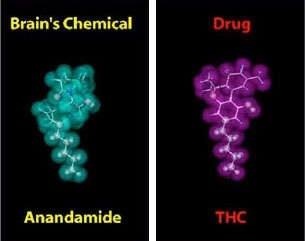Marijuana usage is growing among adolescents and young adults. We decided to investigate how one of its principal chemicals — tetrahydrocannabinol, otherwise known as THC — impacts the hippocampus, both in the short-term and long-term.
Effects of THC on the Hippocampus
 Adi Raman (AB '23) and
Adi Raman (AB '23) and
 Jonathan Lei
(AB '23)
Jonathan Lei
(AB '23)
The Hippocampus
The hippocampus is a seahorse-shaped structure in the body’s
limbic system
associated with emotions and memories. More importantly though, the hippocampus is the brain’s storage
center for one’s conscious, explicit memories.
However, how would external substances impact the
function of the
hippocampus? Drugs such as methamphetamine and cocaine have been heavily documented for their deleterious
effects on the human body, but certain drugs — including cannabis/marijuana — have not been deemed as
particularly harmful. With cannabis legalization becoming more widespread in the United States as a pain
reliever, scientists have explored how the compounds inside marijuana may impact the
hippocampus, yielding undesirable effects.[9]

The location of the hippocampus in the brain. Link
THC

The brain's chemical's structure (Anandamide) vs THC's chemical structure
Marijuana contains a chemical compound known as 9-delta-tetrahydrocannabinols (THC) that generates a
pleasurable
sensation.[11]
THC is no new discovery; scientists extracted it from plants as early as the 1940s.[10] Regardless, because
of
increased
marijuana usage amongst the general public, scientists are still frequently making new discoveries of the
compound’s effects on the hippocampus.
THC is incredibly potent because our body possesses its own endocannabinoid system (ECS); the ECS
comprises a vast network of chemical signals and cellular receptors that are densely packed throughout our
brains and bodies. The cannabinoid-1 receptors (CB1) in the central nervous system (CNS) — meaning the
brain and spinal cord — outnumber many of the other receptor types on the brain. They are the "traffic
cops" that monitor the levels and activity of many other
neurotransmitters. To stimulate these receptors, our bodies produce lipid neurotransmitters called
endocannabinoids,
which are structurally similar to molecules in the cannabis plant. When endocannabinoids bond with CB1
receptors, the brain receives a signal to release dopamine, the "pleasure chemical." (The first
endocannabinoid that
was
discovered
was named anandamide after the Sanskrit word ananda for bliss). Simply put, we all possess tiny
cannabis-like
molecules
swimming around in our brains.
THC as a Neurotransmitter
The cannabis plant, which humans have been using for about 5,000 years, hijacks this cellular machinery. The brain's anandamide (C21H30O2) and marijuana's tetrahydrocannabinol (C22H37O2) compounds have very similar chemical structures; the two are very similar in molar mass and contain nonpolar regions (C-H) and polar regions (C-O), allowing both to interact with the CB1 receptor’s active site to trigger the release of dopamine.

THC acts as a competitive inhibitor, binding to CB1 receptors and crowding out natural endocannabinoids
With THC binding to the brain’s cannabinoid receptors, it competitively inhibits the binding of
anandamide
to the CB1 receptor. While triggering the release of dopamine, it
"crowds out" natural endocannabinoids from binding to the CB1 receptors.
First and foremost, THC's binding to CB1 receptors disrupts the flow of information and feedback between
neurons.
Further, THC
signals the brain to release a significantly larger amount of dopamine than anandamide does, creating a
significantly more pleasing experience for the cannabis user. As a result, the human brain signals the
body to produce fewer natural endocannabinoids on its own, resulting in the cannabis becoming more and
more responsible for the brain's pleasure and thus resulting in users consuming them in greater
quantities.
When THC consumption is reduced, effects wane, resulting in the human body lacking an
appropriate amount of endocannabinoids. This effect — which only occasionally occurs — is called
cannabis
withdrawal syndrome
, or CWS.[1]
Effects of THC on the Hippocampus
Whereas THC can bind to CB1 receptors to force the release of dopamine to our body at a higher level than
the naturally-occuring anandamide chemical, how can THC affect other parts of the brain such as the
hippocampus?
Because CB1 receptors
can be found all
throughout
the
central nervous system, they are also present in the hippocampus. Mice without CB1 receptors have better
memory, suggesting that CB1 receptors help forget memories. [6]
A prevailing theory is that the overload of dopamine lead to THC binding to
CB1 receptors, triggering the process of forgetting memories. As such, extended use of THC can lead to worse
memory. Further, the usage of THC can make the brain fundamentally alter the way memories are formed. In a
study involving rats, researchers found that when rats are given THC in childhood and adolescence, they develop weakened
pathways for memory formation that affect them into adulthood.

In this study, teenage rats given THC (right image) experienced disrupted neuron activity (shown in green) compared to rats not given THC (left image), causing long-term brain damage that continued into adulthood. Link.
In fact, more research has shown that chronic marijuana users have
significantly smaller hippocampuses than people who
do not use marijuana [12]. In addition, marijuana exacerbates the
age-related loss of hippocampal neurons,
leading to cases of short term memory loss. [11]
Certain conditions such as depression, which can make it difficult to pay attention well, can make an
individual even more prone to memory loss. Considering that nearly 25% of adults with depression use
marijuana, damage to the hippocampus and consequent memory loss is easily exacerbated [5]. In a study involving teenage rats, brain damage persisted into
adulthood. On the other hand, for adults, interestingly chronic abstinence in marijuana users will return
hippocampus size to normal, suggesting that marijuana’s effects, albeit harmful, may not be as permanent
for adults as opponents of the drug may claim.[12]
Broader Implications
Thus, although empirical evidence has shown that THC’s addictive properties can damage the hippocampus
and lead to biological, psychological, and social alterations in cannabis users, these effects do not seem
to be permanent. Still, THC significantly inhibits short-term memory formation, which can prove
detrimental, especially in demanding situations.
Cannabis’ widespread usage has only manifested in the last two decades, and states
are only becoming more lenient with the drug. There may be many other unknown effects of the drug,
including long-term ones, so it's important that we continue to devote resources and attention to further
research — with studies showing that pre-teen, adolescent, and young adult marijuana usage are more likely
to
perform poorly in school and face conflict with the law, it's important to understand how it impacts the
brain.
Potential Further Investigation
Effects of CBD
CBD is another compound found in cannabis. It has been shown to reduce the effects of THC, and may be useful in treating the negative effects of THC. Further research is needed to determine whether CBD can be used to treat the negative effects of THC on the hippocampus.
Other brain functions
We lacked the time to fully investigate THC's impact on the brain as a whole, but it has been proven to increase blood flow. As such, a holistic investigation of THC's effects on the entire brain may be beneficial to truly understand its effects.
Works Cited
-
Bonnet, Udo, and Ulrich W Preuss. "The Cannabis Withdrawal Syndrome: Current Insights."
Substance Abuse and Rehabilitation, Dove Medical Press, 27 Apr. 2017, https://www.
ncbi.nlm.nih.gov/pmc/articles/PMC5414724/. -
"Endocannabinoids: What Are They and What Do They Do?" Medical News,
Today
MediLexicon International, 21 Feb. 2021, https://www.medicalnewstoday.com/
articles/endocannabinoid#definition. -
Gorfinkel, Lauren R et al. “Association of Depression With Past-Month Cannabis Use
Among US Adults Aged 20 to 59 Years, 2005 to 2016.” JAMA network open vol. 3,8
e2013802. 3 Aug. 2020, doi:10.1001/jamanetworkopen.2020.13802 - "How Does Marijuana Produce Its Effects?" National Institutes of Health, U.S. Department of
Health and Human Services, 13 Apr. 2021, https://nida.nih.gov/publications/research
-reports/marijuana/how-does-marijuana-produce-its-effects - Jacobs, Andrew. "Use of Marijuana and Psychedelics Is Soaring among Young Adults, Study
Finds." The New York Times, The New York Times, 23 Aug. 2022, https://www.nytimes.
com/2022/08/23/health/marijuana-psychedelics-young-adults.html. -
Konopka, Lukasz M. "Marijuana Use: Neuroscience Perspective." Croatian Medical Journal,
vol. 55, no. 3, 2014, pp. 281–283., doi:10.3325/cmj.2014.55.281. -
Myers, David G. "Module 11: Studying the Brain, Older Brain Structures, and the
Limbic
System." Myers' Psychology for AP, Worth Publishers, New York, NY, 2014. -
Peter Grinspoon, MD. "The Endocannabinoid System: Essential and Mysterious." Harvard
Health, Harvard Health Publishing, 11 Aug. 2021, https://www.health.harvard.edu/blog/
the-endocannabinoid-system-essential-and-mysterious-202108112569
- Schaeffer, Katherine. "6 Facts about
Americans and Marijuana." Pew Research Center, Pew
Research Center, 23 Aug. 2021, https://www.pewresearch.org/fact-tank/2021/04/26
/facts-about-marijuana/. -
Silva, Lauren. "CBD vs. THC: What’s the Difference?" Forbes Health, 7 June 2022,
www.
forbes.com/health/body/cbd-vs-thc/. -
"What Are Marijuana's Long-Term Effects on the Brain?" National Institutes of Health, U.S.
Department of Health and Human Services, 13 Apr. 2021, https://nida.nih.gov/
publications/research-reports/marijuana/what-are-marijuanas-long-term-effects-brain. - Yücel, M, et al. "Hippocampal Harms, Protection and Recovery Following Regular Cannabis
Use." - Translational Psychiatry,
Nature Publishing Group, 12 Jan. 2016,
https://www.ncbi.nlm.nih.gov/pmc/articles/PMC5068875/.